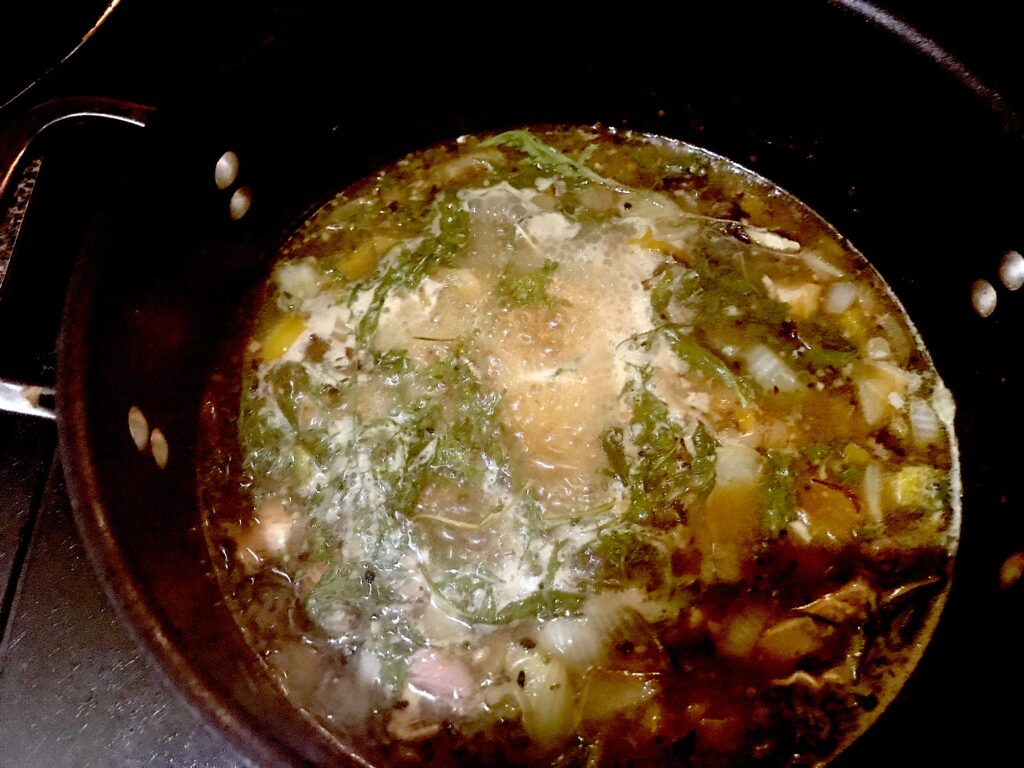
Turkey soup with Peppergrass for flavoring and pot herb. Photo by Green Deane
Your salad days are supposed to be your best days. We saw that for foraging last weekend. Despite the frigid weather it is the salad greenery time of year. Besides salad plants there are also plants for fermentation, tea, and flavoring. As of last week the only seasonal plants we didn’t see were chickweed, henbit, and western tansy mustard.
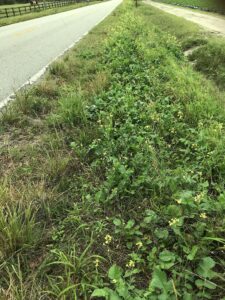
This is the common place to find mustard or radish plants this time of year, a streak of yellow blossoms beside the road. Photo By Green Deane
Many of the plants starting their seasonal run are spring or summer plants in more northern climates. It is too hot locally for them to grow in the our spring or summer, so they opt for winter. Several members of the mustard family can easily be fermented into sauerkraut or also dried to preserve them. Wild mustard, photo right, is a good candidate for either. Peppergrass, which is here all year, likes the cooler weather and is more plentiful now. It’s a good green to add to soups or stews for a bit of peppery flavor, magnesium and vitamin C. Wild comestibles this time of year include young Caesar weed, West Indian chickweed, the aforementioned peppergrass, sow thistle, pony foot, false hawk’s beard, cucumber weed, young Spanish needles, true thistles, and lacebark elm leaves. I fermented some wild mustard this past week. And added some peppergrass to some smoked turkey soup. During our Urban Crawl we also saw many flushes of Ringless Honey Mushrooms, a bit later in the season than usual, perhaps they were waiting for the cold spell.
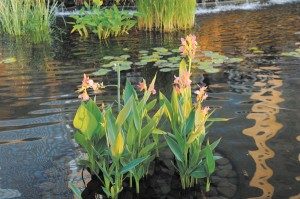
Canna can grow in a wet garden or a pond.
♣ Botany Builder #12. Do you remember the confusion in school over the words immigrant and emigrant? An emigrant is someone leaving a country, and an immigrant is someone entering a country. An emergent plant is one coming out of the water, such as Canna. It likes to grow in about a half a foot of water. It doesn’t like dry land and it doesn’t like deep water. It is emergent. Cattails are emergent, however some species of cattail — there aren’t that many — like to be close to shore and others like deeper water. What it really comes down to, can you get cattails from shore or do you need a canoe? Cann shoots can be cooked like asparagus, the long roasted roots are a staple food in Central America.

Classes are held rain or shine or cold. (Hurricanes are an exception.) Photo by Kelly Fagan.
One foraging class this weekend (Saturday) so we can all, reflect on New Year’s Day.
Saturday December 31st Blanchard Park, 2451 N Dean RD
Orlando, FL 32817. Meet at the pavilion next to the tennis courts.
Saturday January 7th Mead Garden: 1500 S. Denning Dr., Winter Park, FL 32789. Meet at the bathrooms. 9 a.m
Sunday January 8th, Wickham Park: 2500 Parkway Drive, Melbourne, FL 32935-2335. Meet at the “dog park” inside the park. 9 a.m.
Sunday January 15th the Princess Place Preserve, 2500 Princess Place Rd, Palm Coast, FL 32137, 9 a.m. Meet at the parking lot.
For more information, to pre-pay or sign up go here.
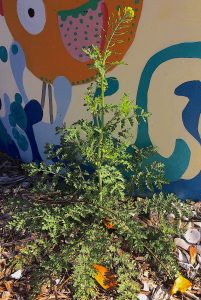
Wester Tansy Mustard is an over overlooked wild edible. Photo by Green Deane
The Western Tansy Mustard is one of our shortest-lived wintertime forageables. It’s not flashy and is often either too small or too old to be seen. It also likes very dry places and cool temperatures. I often find it dusty areas where you find livestock such as paddocks and corrals. Of all the micro-mustards it is the mildest in flavor, at least for humans. The texture is fuzzy. More confusing is there is no Eastern Tansy Mustard. You read about the Western Tansy Mustard here.
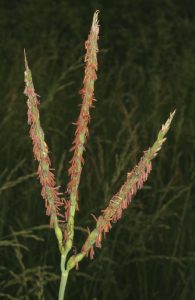
Eastern Gammagrass in blossom.
Grass and ice cream are usually not considered at the same thought unless it is Eastern Gamagrass. Why? Because livestock like the clumping Tripsacinae so much cattlemen call in Ice Cream Grass. While it can be used like wheat it’s a distant relative of corn and can be popped. Eastern Gamagrass, also called Fakahatchee Grass, is sod-forming and can reach up to eight-feet tall. Though it is pollinating and seeding now the grass can seed from now to September. The frilly male flowers occupy the top three-fourths of the seed spike and the stringy female flowers the bottom fourth. In this species the ladies are brown, hair-like structures. Besides fodder Eastern Gamagrass is also a common ornamental found in parks and residential areas. A bunch can live to be 50-years old or more. Fakahatchee, by the way, means either Forked River or Muddy River. Opinions vary. To read more about Eastern Gamagrass go here.
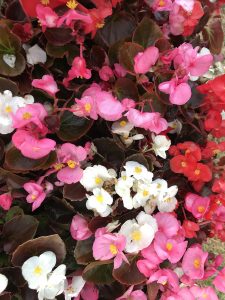
Begonias’ flavor varies with color and growing medium. Photo by Green Deane
This might be a good time to mention that Begonias are edible. We saw some this weekend furing out Urban Crawl. Unfortunately a rather popular book some 30 years ago said they are not edible. I actually spoke with the author once and she told me in subsequent editions that mistake would be changed but the book never went into second edition. Thus the mistake can be found on the internet. Begonias are not only the favorite of growers (and cemetery pots) they are naturalized locally. I see them often in damp spots such as stream banks or drainage ditches. The leaves are edible as well as the blossoms. They can be prepared in a variety of ways and the juice is also a vegetarian rennet. My favorite are wax begonias (and the flavor can vary with their color.) You can read about them here.

You get the USB, not the key.
My nine-DVD set of 135 videos has been phased out and replaced by 171-videos on a 128-GB USB, see right. The USB videos are the same videos I have on You Tube. Some people like to have their own copy especially if social order falters. The USB videos have to be copied to your computer to play. If you want to order the USB go to the DVD/USB order button on the top right of this page or click here. That will take you to an order form. Or you can make a $99 donation, which tells me it is for the USB (include a snail-mail address.) I’d like to thank all of you who ordered the DVD set over the years which required me to burn over 5,000 DVDs individually. I had to stop making them as few programs now will read the ISO files to copy them. Burning a set also took about three hours.

Green Deane Forum
Want to identify a plant? Perhaps you’re looking for a foraging reference? You might have a UFO, an Unidentified Flowering Object, you want identified. On the Green Deane Forum we — including Green Deane and others from around the world — chat about foraging all year. And it’s not just about warm-weather plants or just North American flora. Many nations share common weeds so there’s a lot to talk about. There’s also more than weeds. The reference section has information for foraging around the world. There are also articles on food preservation, and forgotten skills from making bows to fermenting food. Recent topics include: Stale Bread and Cod Liver Oil, Killing Bugs with Tobacco Plugs, Eating weeds: Is it safe? Have they mutated? Not the Eastern Red Bug but the Pink Tabebuia, African Tulip Tree, Asparagus densiflorus, Green Deane’s Book… You can join the forum by clicking on the button on the upper right hand side of this page.
This is my weekly newsletter #537. If you want to subscribe to this free newsletter you can find the sign-up form in the menu at the top of the page. My website, EatTheWeeds.com, which is data secure, has over 1500 plants on it in some 428 articles. I wrote every one myself, no cut and paste.
To donate to the Green Deane Newsletter click here.


Hello Mr. Green Dean,
Do you ever come further south than Mounds in WPB?
Like Flamingo Gardens in Davie.
Thank you for your never ending weed compendium.
All the Best to You and Yours.
Jp
Hello,
I am hoping to attend one of your workshops, do you have one at Lake Louisa state park this coming year?
Thank you so much for sharing your knowledge
Pam Dickey
Hi! I have been a follower for some time and have been on a few walks with you. One private one in Crystal River, and some of your usual, and at the earthskills gathering. I found a ganoderma curtisii as was confirmed from the Central Florida Mushroom Identification group. I have been making tinctures for a long time, but most have been from mountain rose herbs. Do you have any knowledge on tincturing or tea with this mushroom that you can share? What I have searched seems to be kind of wishy washy. Thanks! Happy New Year!